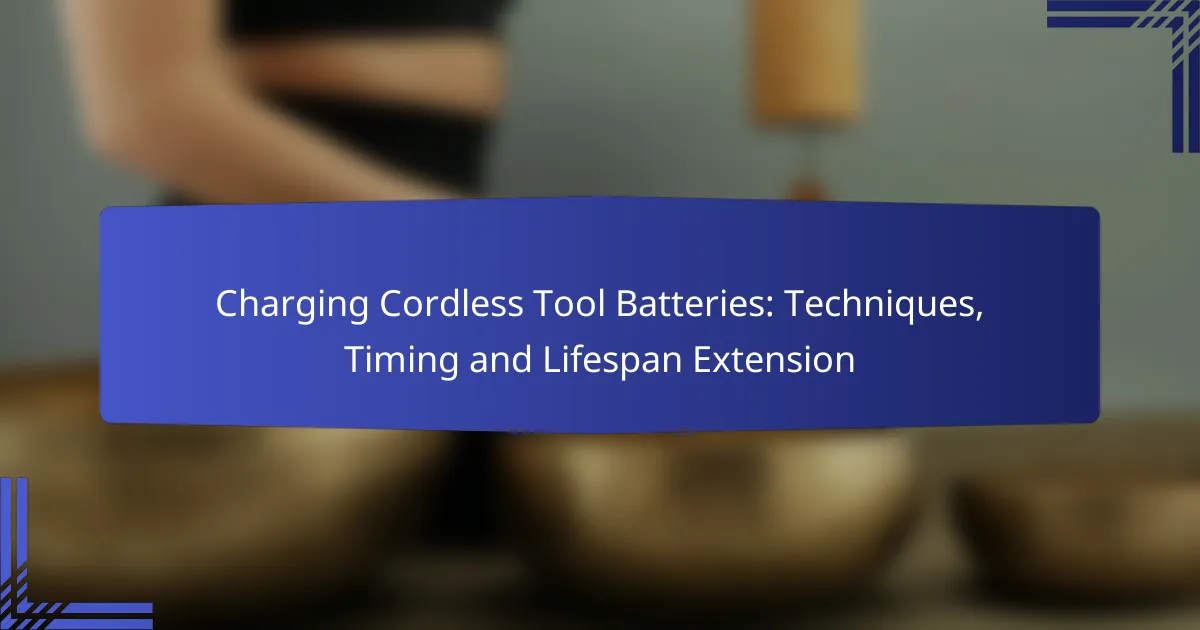Charging cordless tool batteries requires careful attention to technique and timing to ensure optimal performance and longevity. By using the correct charger, monitoring temperature, and avoiding overcharging, you can significantly enhance battery life. Additionally, implementing proper storage and maintenance practices will further extend the lifespan of your batteries.
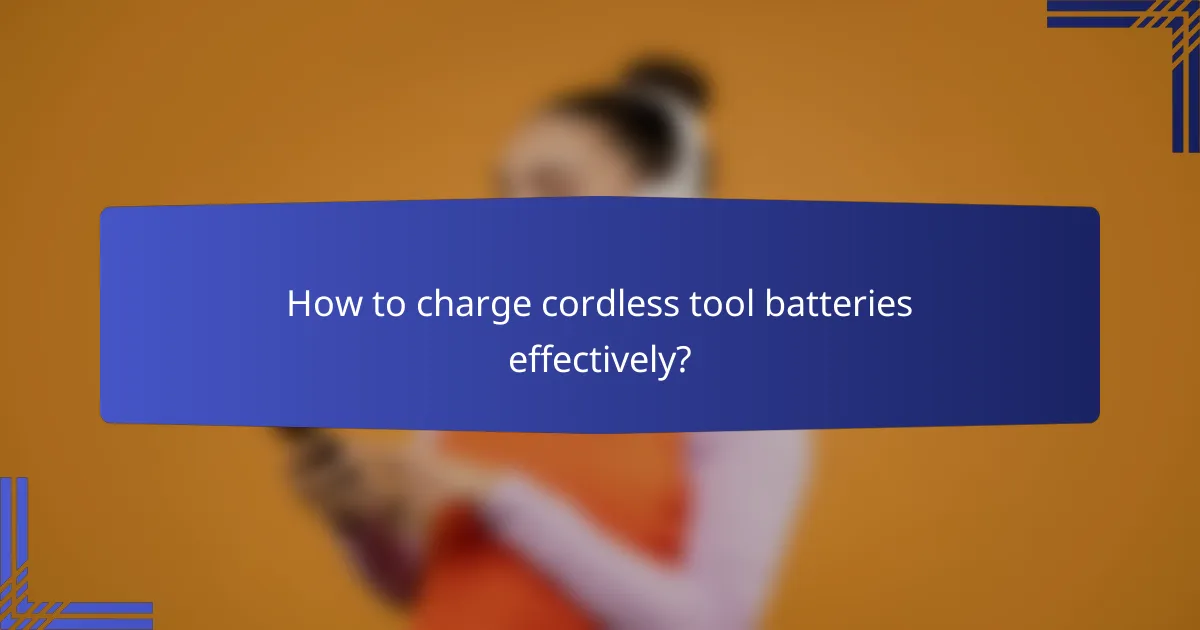
How to charge cordless tool batteries effectively?
To charge cordless tool batteries effectively, use the correct charger, monitor the temperature, and avoid overcharging. Following these practices can enhance battery performance and lifespan.
Use the manufacturer’s charger
Always use the charger specifically designed for your cordless tool’s battery. Manufacturer chargers are optimized for the battery’s chemistry and voltage, ensuring safe and efficient charging.
Using third-party chargers can lead to improper charging, which may damage the battery or reduce its lifespan. Stick to the original equipment for best results.
Charge at room temperature
Charging batteries at room temperature, ideally between 20°C and 25°C (68°F to 77°F), is crucial for optimal performance. Extreme temperatures can affect the battery’s ability to charge effectively.
Cold temperatures can slow down the charging process, while excessive heat can lead to overheating and potential damage. Always ensure the charging environment is stable and within this range.
Avoid overcharging
Overcharging can significantly shorten the lifespan of cordless tool batteries. Most modern chargers have built-in mechanisms to prevent overcharging, but it’s still wise to monitor the charging process.
Disconnect the battery once it reaches full charge to avoid unnecessary wear. If your charger lacks an automatic shut-off feature, consider investing in one that does.
Follow recommended charging times
Adhere to the manufacturer’s recommended charging times for optimal battery health. Charging times can vary based on battery size and type, typically ranging from one to several hours.
Refer to the user manual for specific guidelines. Avoid charging for longer than necessary, as this can lead to overheating and decreased battery capacity over time.

What are the best practices for extending battery lifespan?
To extend the lifespan of cordless tool batteries, it is essential to follow specific practices that optimize their performance and longevity. Key strategies include proper storage, regular maintenance, and consistent usage to prevent degradation.
Store batteries in a cool, dry place
Storing batteries in a cool, dry environment helps prevent overheating and moisture damage, both of which can significantly shorten battery life. Ideal storage temperatures typically range from 10°C to 25°C (50°F to 77°F).
Avoid placing batteries in direct sunlight or near heat sources, as elevated temperatures can lead to chemical breakdown. Using a dedicated storage container can also protect batteries from humidity and physical damage.
Perform regular maintenance checks
Regular maintenance checks are crucial for identifying any issues that could affect battery performance. Inspect batteries for signs of corrosion, leakage, or physical damage, and clean the terminals as needed to ensure a good connection.
Additionally, consider checking the charge level periodically. Keeping batteries charged between 20% and 80% can help maintain their health and prevent deep discharges, which can be detrimental to lithium-ion batteries.
Use batteries regularly
Using batteries on a regular basis helps maintain their charge cycles and overall health. If batteries are left unused for extended periods, they may enter a state of deep discharge, which can lead to capacity loss.
To keep batteries in optimal condition, aim to use them at least once every few months. If you have multiple batteries, rotate their usage to ensure even wear and prolong their lifespan.

What are the common charging mistakes to avoid?
Avoiding common charging mistakes can significantly enhance the lifespan and performance of cordless tool batteries. Key errors include using incompatible chargers, leaving batteries on the charger for extended periods, and ignoring battery health indicators.
Using incompatible chargers
Using chargers that are not designed for your specific battery type can lead to damage or inefficient charging. Each battery has unique voltage and current requirements, and mismatched chargers may not deliver the correct power, potentially causing overheating or reduced battery life.
Always check the manufacturer’s specifications for your battery and use only compatible chargers. This ensures optimal charging performance and helps maintain the integrity of the battery over time.
Leaving batteries on the charger too long
Prolonged charging can lead to overcharging, which may damage the battery cells and reduce overall capacity. Most modern chargers have built-in mechanisms to prevent overcharging, but it’s still wise to unplug the charger once the battery is fully charged.
A good rule of thumb is to monitor charging times and remove the battery once it reaches full capacity, typically within a few hours. Setting a timer can help avoid this common pitfall.
Ignoring battery health indicators
Many cordless tool batteries come equipped with health indicators that provide insights into their condition. Ignoring these indicators can lead to using a battery that is no longer performing optimally, resulting in decreased efficiency and shorter usage times.
Regularly check the health indicators and replace batteries that show signs of wear or reduced capacity. This proactive approach can save you time and money in the long run by ensuring you always have reliable power for your tools.
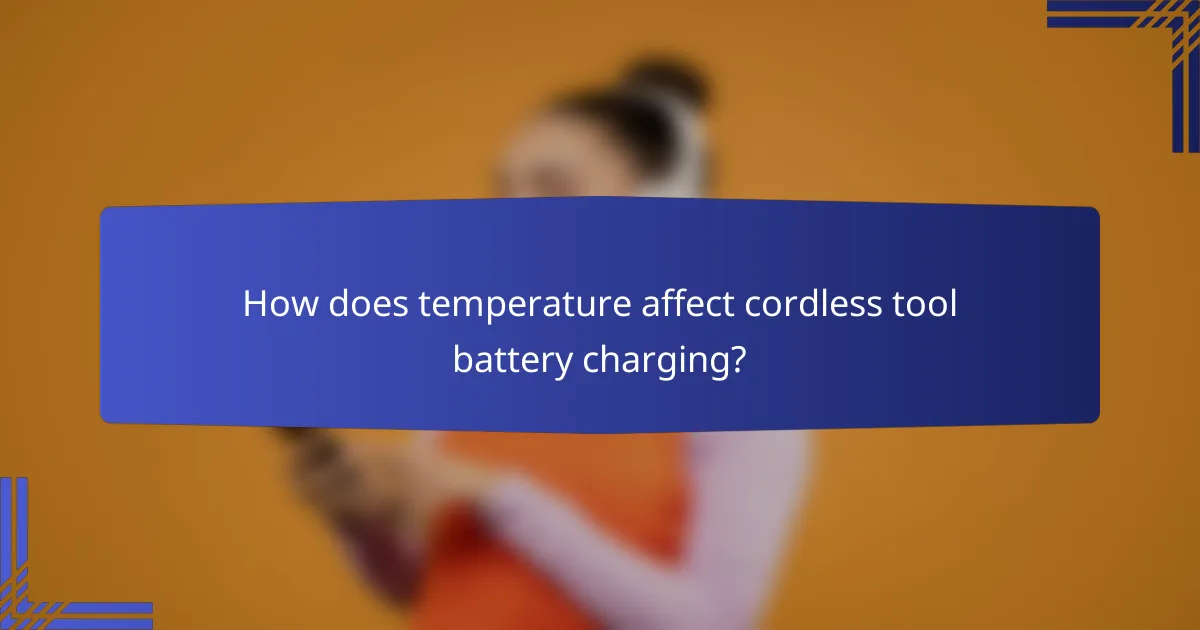
How does temperature affect cordless tool battery charging?
Temperature significantly impacts the charging process of cordless tool batteries. Both extreme heat and cold can affect charging efficiency, battery lifespan, and overall performance.
Charging in extreme heat can damage batteries
High temperatures can lead to overheating, which may cause irreversible damage to battery cells. When charging in extreme heat, the chemical reactions inside the battery can accelerate, leading to swelling, leakage, or even fire hazards.
To prevent damage, it is advisable to charge batteries in a cool, well-ventilated area. If the battery feels hot to the touch, stop charging immediately and allow it to cool down before continuing.
Cold temperatures can slow charging
Cold weather can slow down the chemical reactions necessary for charging, resulting in longer charging times or incomplete charging. In temperatures below freezing, batteries may not charge effectively at all.
To optimize charging in cold conditions, bring the battery to room temperature before connecting it to the charger. If charging outdoors, consider using insulated bags or warm environments to maintain optimal battery performance.
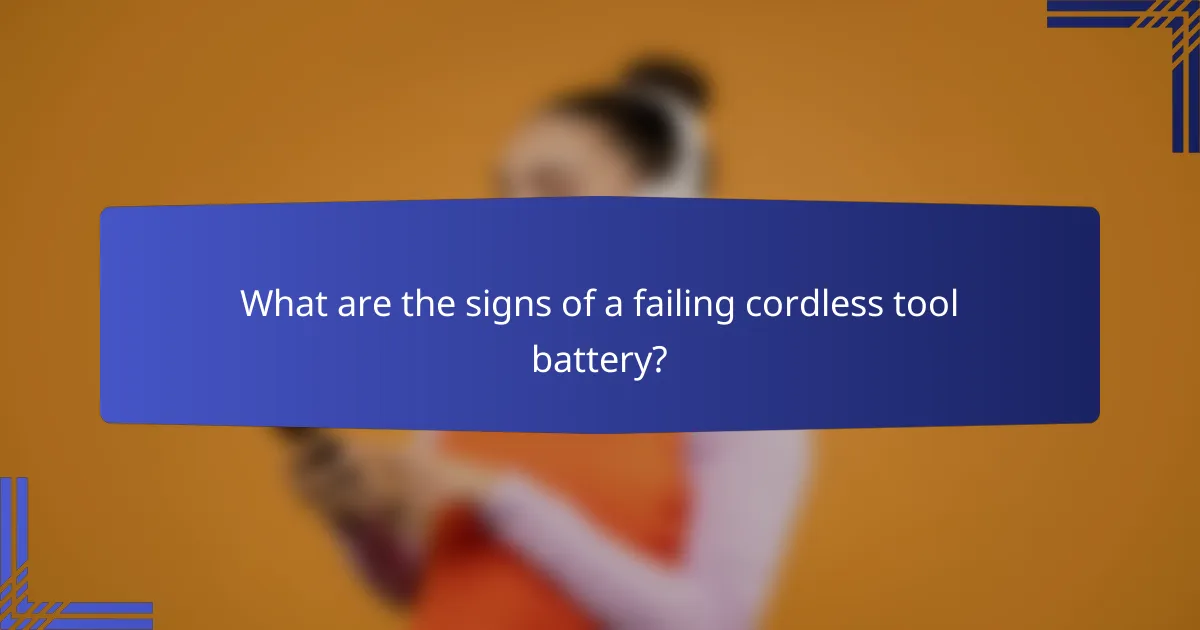
What are the signs of a failing cordless tool battery?
Signs of a failing cordless tool battery include decreased runtime, physical damage, and inconsistent charging. Recognizing these indicators early can help you decide whether to replace or recycle the battery.
Decreased runtime
A significant decrease in runtime is one of the most noticeable signs that a cordless tool battery is failing. If a battery that once lasted hours now only operates for a fraction of that time, it may be nearing the end of its life.
To assess this, compare the current performance with the original specifications. If the runtime has dropped by more than 20-30%, it’s time to consider replacement options.
Swelling or physical damage
Physical signs such as swelling, cracks, or leaks indicate serious issues with a cordless tool battery. Swelling often occurs due to gas buildup inside the battery, which can be dangerous.
Inspect your batteries regularly for any visible damage. If you notice any deformities, discontinue use immediately and dispose of the battery according to local regulations.
Inconsistent charging
If a cordless tool battery fails to charge fully or takes an unusually long time to charge, it may be failing. This inconsistency can lead to unreliable tool performance and frustration during use.
To troubleshoot, try charging the battery in different chargers or outlets. If the problem persists, it’s advisable to replace the battery to ensure optimal tool functionality.
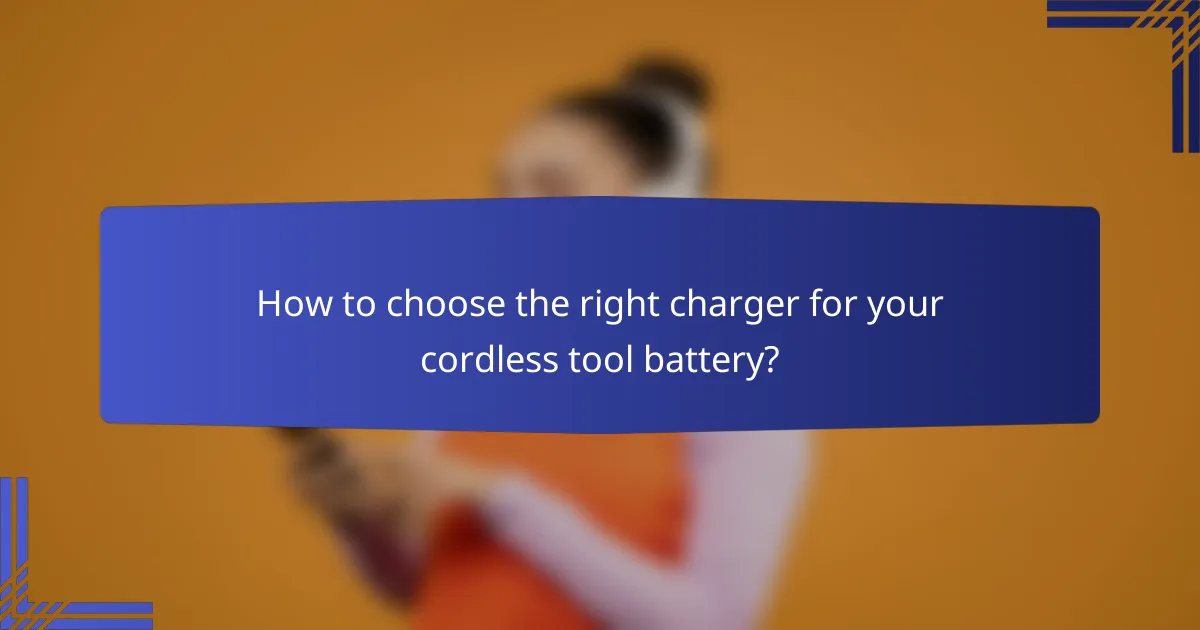
How to choose the right charger for your cordless tool battery?
Selecting the right charger for your cordless tool battery is crucial for optimal performance and longevity. Consider the battery type, voltage, and compatibility with your tools to ensure efficient charging and safety.
Understand battery types
Different cordless tools use various battery chemistries, such as lithium-ion, nickel-cadmium, or nickel-metal hydride. Each type has specific charging requirements, so it’s essential to match the charger to the battery chemistry for safe and effective charging.
For instance, lithium-ion batteries typically require smart chargers that prevent overcharging, while nickel-cadmium batteries can use simpler chargers. Always check the manufacturer’s specifications for compatibility.
Check voltage compatibility
Voltage compatibility is vital when choosing a charger. Most cordless tools operate at standard voltages, such as 12V, 18V, or 20V. Using a charger with the correct voltage ensures that the battery charges efficiently without risk of damage.
For example, using a 20V charger on an 18V battery can lead to overheating and reduced lifespan. Always verify the voltage rating on both the charger and the battery before use.
Consider charging speed
Charging speed varies by charger, with some offering rapid charging capabilities while others take longer. Fast chargers can significantly reduce downtime, but they may generate more heat, which can affect battery lifespan.
For regular use, a standard charger that takes a few hours may be sufficient, while professionals might prefer a fast charger for quicker turnaround. Balance your need for speed with the potential impact on battery health.
Look for safety features
Safety features in chargers can prevent accidents and prolong battery life. Look for chargers with built-in protections against overcharging, short circuits, and overheating.
Smart chargers that automatically adjust the charging rate based on battery condition are particularly beneficial. These features help maintain battery health and ensure safe operation.
